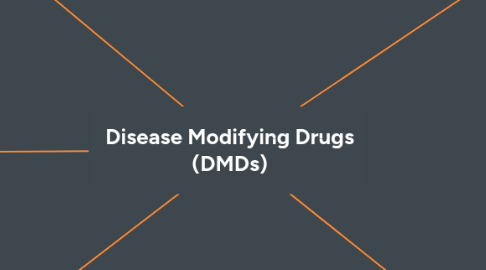
1. Disease Modifying Anti-Rheumatic Drugs (DMARDS)
1.1. Leflunomide (Arava)
1.1.1. FDA approved for use in only
1.1.1.1. Rheumatoid Arthritis
1.1.1.2. Psoriatic Arthritis
1.2. Methotrexate
1.2.1. Originally developed as chemotherapy for CA
1.2.2. Well tolerated in low dose as first line tx for autoimmune disorders
1.2.2.1. rheumatoid arthritis
1.2.2.2. juvenile dermatomyositis
1.2.2.3. psoriasis
1.2.2.4. psoriatic arthritis
1.2.2.5. lupus
1.2.2.6. sarcoidosis
1.2.2.7. Crohn's disease
1.2.3. Well tolerated with combination use w/NSAIDs (aspirin) or pain med e.g. Acetaminophen (Tylenol)
1.3. Minocycline (Minocin)
1.3.1. Antibiotic of the Tetracycline class with Immune-Suppression side effect makes it an option as a DMARD (Doxycline - another antibiotic also has same property)
1.3.2. Despite its anti-immune effect, the American College of Rheumatology guidelines presently doesn't list this as a treatment of RA but it is used nonetheless
2. Disease Modifying Anti-Osteoarthritis Drugs (DMOADS)
2.1. Classified as CAMS - available as health supplements - Also read Ciccone (5th ed - pg. 645)
2.1.1. Chondroitin sulfate
2.1.2. Glucosamine sulfate (also see both these links: https://en.wikipedia.org/wiki/Glucosamine#cite_note-ARC_report-16)
3. Side-effects of DMARDS
3.1. Leflunomide
3.1.1. Dose-limiting Side-effects
3.1.1.1. liver damage
3.1.1.2. lung disease
3.1.1.3. immunosuppression
3.1.2. Common Side-effects
3.1.2.1. diarrhea
3.1.2.2. respiratory tract infections
3.1.2.3. hair loss
3.1.2.4. high blood pressure
3.1.2.5. rash
3.1.2.6. nausea
3.1.2.7. bronchitis
3.1.2.8. headache
3.1.2.9. abdominal pain
3.1.2.10. abnormal liver function tests
3.1.2.11. back pain
3.1.2.12. indigestion
3.1.2.13. urinary tract infection
3.1.2.14. dizziness
3.1.2.15. infection
3.1.2.16. joint disorder
3.1.2.17. itchiness
3.1.2.18. weight loss
3.1.2.19. loss of appetite
3.1.2.20. cough
3.1.2.21. gastroenteritis
3.1.2.22. pharyngitis
3.1.2.23. stomatitis
3.1.2.24. tenosynovitis
3.1.2.25. vomiting
3.1.2.26. weakness
3.1.2.27. allergic reaction
3.1.2.28. chest pain
3.1.2.29. dry skin
3.1.2.30. eczema
3.1.2.31. paraesthesia
3.1.2.32. pneumonia
3.1.2.33. rhinitis
3.1.2.34. synovitis
3.1.2.35. cholelithiasis
3.1.2.36. shortness of breath
3.1.3. Uncommon Side-effects ((occurring in 0.1-1% of those treated with the drug) include
3.1.3.1. constipation,
3.1.3.2. oral thrush,
3.1.3.3. stomatitis,
3.1.3.4. taste disturbance,
3.1.3.5. thrombocytopenia
3.1.3.6. hives
3.2. Methotrexate (even in lower doses as DMARDS) has similar side-effects as in chemotherapy for Cancers
3.2.1. Hair loss
3.2.2. Nausea
3.2.3. Headaches
3.2.4. Skin pigmentation
3.3. Minocycline - As an ABx - it has inherent side-effects of all antiobiotics (ABx) plus some important other issues - see at the nodes
3.3.1. Common Side-effects
3.3.1.1. upset stomach
3.3.1.2. diarrhea, dizziness, unsteadiness, drowsiness,
3.3.1.3. mouth sores,
3.3.1.4. headache
3.3.1.5. vomiting
3.3.1.6. Discoloration of Skin
3.3.1.6.1. Some of this may disappear with discontinuation but, some parts might not
3.3.1.7. It increases sensitivity to sunlight
3.3.1.8. sleep disorders (rare
3.3.2. Dangerous past expiry date!
3.3.2.1. Serious damage to the kidney
4. Relevance to PT
4.1. Huge importance
4.1.1. Modifies the very MSK disorders that are associated with widespread joint dysfunction - Bread & Butter of PTs
4.2. Side-effects are major mainly for DMARDS
4.2.1. PTs need to monitor patients for side-effects - Anything that is out of ordinary for patient may be drug related (may not be, but that is for you to analyze)
4.2.2. Side-effects can be toxic and make patient not feel like participate in Physical Therapy - You may have to figure out certain days to work with patient.
4.3. DMOADS are not well studied
4.3.1. Watch for Bleeding Risk when used concurrently with Blood Thinner Warfarin
